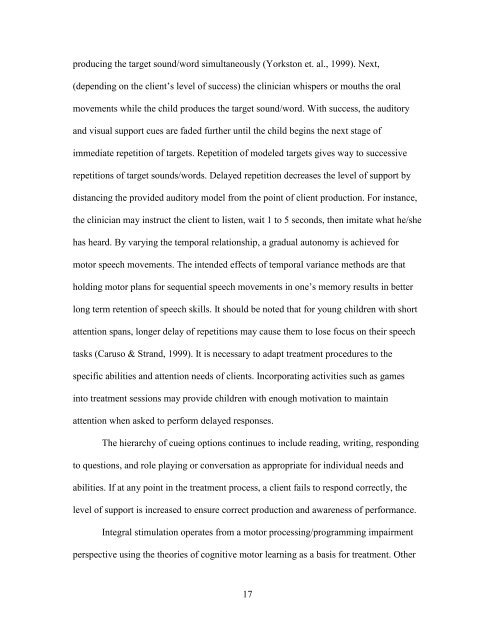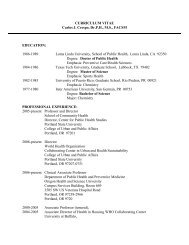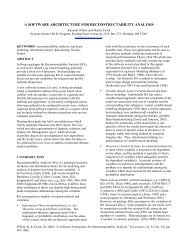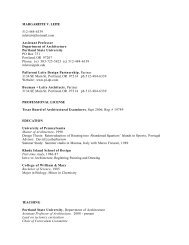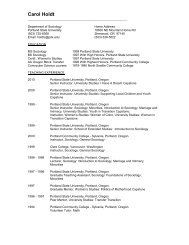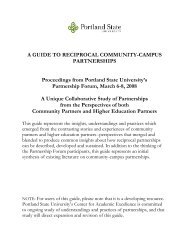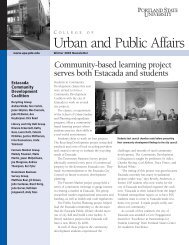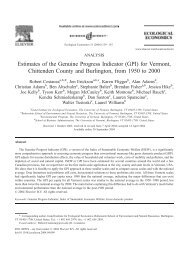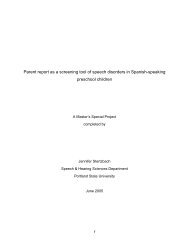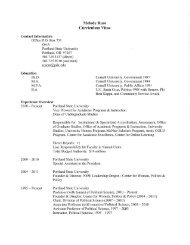Effects of integral stimulation therapy on speech - Portland State ...
Effects of integral stimulation therapy on speech - Portland State ...
Effects of integral stimulation therapy on speech - Portland State ...
Create successful ePaper yourself
Turn your PDF publications into a flip-book with our unique Google optimized e-Paper software.
producing the target sound/word simultaneously (Yorkst<strong>on</strong> et. al., 1999). Next,<br />
(depending <strong>on</strong> the client’s level <str<strong>on</strong>g>of</str<strong>on</strong>g> success) the clinician whispers or mouths the oral<br />
movements while the child produces the target sound/word. With success, the auditory<br />
and visual support cues are faded further until the child begins the next stage <str<strong>on</strong>g>of</str<strong>on</strong>g><br />
immediate repetiti<strong>on</strong> <str<strong>on</strong>g>of</str<strong>on</strong>g> targets. Repetiti<strong>on</strong> <str<strong>on</strong>g>of</str<strong>on</strong>g> modeled targets gives way to successive<br />
repetiti<strong>on</strong>s <str<strong>on</strong>g>of</str<strong>on</strong>g> target sounds/words. Delayed repetiti<strong>on</strong> decreases the level <str<strong>on</strong>g>of</str<strong>on</strong>g> support by<br />
distancing the provided auditory model from the point <str<strong>on</strong>g>of</str<strong>on</strong>g> client producti<strong>on</strong>. For instance,<br />
the clinician may instruct the client to listen, wait 1 to 5 sec<strong>on</strong>ds, then imitate what he/she<br />
has heard. By varying the temporal relati<strong>on</strong>ship, a gradual aut<strong>on</strong>omy is achieved for<br />
motor <strong>speech</strong> movements. The intended effects <str<strong>on</strong>g>of</str<strong>on</strong>g> temporal variance methods are that<br />
holding motor plans for sequential <strong>speech</strong> movements in <strong>on</strong>e’s memory results in better<br />
l<strong>on</strong>g term retenti<strong>on</strong> <str<strong>on</strong>g>of</str<strong>on</strong>g> <strong>speech</strong> skills. It should be noted that for young children with short<br />
attenti<strong>on</strong> spans, l<strong>on</strong>ger delay <str<strong>on</strong>g>of</str<strong>on</strong>g> repetiti<strong>on</strong>s may cause them to lose focus <strong>on</strong> their <strong>speech</strong><br />
tasks (Caruso & Strand, 1999). It is necessary to adapt treatment procedures to the<br />
specific abilities and attenti<strong>on</strong> needs <str<strong>on</strong>g>of</str<strong>on</strong>g> clients. Incorporating activities such as games<br />
into treatment sessi<strong>on</strong>s may provide children with enough motivati<strong>on</strong> to maintain<br />
attenti<strong>on</strong> when asked to perform delayed resp<strong>on</strong>ses.<br />
The hierarchy <str<strong>on</strong>g>of</str<strong>on</strong>g> cueing opti<strong>on</strong>s c<strong>on</strong>tinues to include reading, writing, resp<strong>on</strong>ding<br />
to questi<strong>on</strong>s, and role playing or c<strong>on</strong>versati<strong>on</strong> as appropriate for individual needs and<br />
abilities. If at any point in the treatment process, a client fails to resp<strong>on</strong>d correctly, the<br />
level <str<strong>on</strong>g>of</str<strong>on</strong>g> support is increased to ensure correct producti<strong>on</strong> and awareness <str<strong>on</strong>g>of</str<strong>on</strong>g> performance.<br />
Integral <str<strong>on</strong>g>stimulati<strong>on</strong></str<strong>on</strong>g> operates from a motor processing/programming impairment<br />
perspective using the theories <str<strong>on</strong>g>of</str<strong>on</strong>g> cognitive motor learning as a basis for treatment. Other<br />
17


